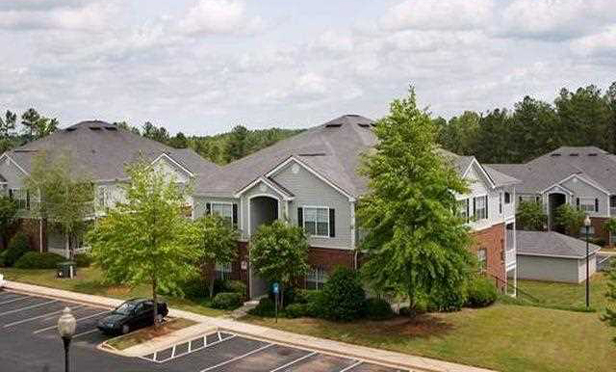
MINNEAPOLIS—The world's going green, and smart investors, developers and tenants are all painting with the same broad paintbrush. So are capital sources and loan servicers, according to Greg Duvall, SVP/managing director, NorthMarq Capital's Kansas City office.
Specifically, Duvall points to Fannie Mae and Freddie Mac, as those two GSEs incentivize borrowers to take advantage of the environmental gains and the cost reductions of their green lending programs. For Freddie, that initiative is dubbed Green Advantage. For Fannie, it's Green Rewards. Whatever the name, the GSEs are, “promoting sustainability for the right reason,” he says, “to encourage people to be environmentally friendly. It's a mandate that comes from their regulator.”
And the GSEs themselves are incentivized to follow that mandate. “Green loans are excluded from their caps,” he says, a fact that's good for lender and borrower. “They pass the pricing benefits on to borrowers, and, in turn, incentivize them.”
Those savings—even before folding in reductions in energy usage—can be significant. “The reduction in pricing for the borrower can be anywhere from 10 bps to 39 bps,” he says. “So borrowers are incentivized to make modifications to their properties to reduce either water or energy usage. And it obviously benefits the occupant as well, so everyone gains, from lender to tenant.”
But, not surprisingly, the two GSEs have slightly different approaches to achieving those savings. (For a comparison, please see chart below).
| Fannie Mae and Freddie Mac “Green” program comparison | ||||
| GSE | Property Age | Post Close requirements | Percent savings achieved | Minimum spend per unit |
| Fannie Mae Green Rewards | N/A | Annually for the life of the loan | 20% | $0 |
| Freddie Mac Green Advantage | 2000 and older | Report annually for four years | 15% | $350 |
| *Changes are anticipated in 2018 for both Fannie Mae and Freddie Mac to eliminate the property age requirement and the minimum per-unit expense and to increase the energy savings requirement. Source: NorthMarq Capital | ||||
As Duvall tells it, while Freddie's program requires the borrower to spend a minimum of $350 per unit with a targeted 15% reduction in either of those categories – water or energy; Fannie has no per-unit minimum. But it does expect a 20% reduction in usage – again either water or energy.
(Editor's note: Since the interview took place, the FHFA released its 2018 guidance for cap exclusion that will require a 25% increase in water or energy efficiency for 2018. Freddie Mac has also changed its per unit minimums and the property age restriction. The full guidance can be found by clicking here.)
“Also,” he says, “Fannie and Freddie track progress differently. Fannie requires documentation through the life of the loan. Freddie requires an annual report during the first four years after the loan closes.” To the benefit of the borrower, he adds, neither GSE dangles a pull-back on pricing. Nevertheless, there are expectations. Fannie gives the borrower 12 months to implement the modifications, Freddie allows 24 months.
It should be noted that, while there are differences as well in the age of eligible assets, these requirements are about to undergo modification. “It was Freddie's policy initially that the properties needed to be 2000 vintage or earlier to qualify,” says Duvall. “Fannie didn't have that restriction.” The coming year should bring about those changes, designed apparently to make Freddie more competitive.
No matter the age of the asset, verification as noted above is key, and Duvall explains that landlords have to provide statements of savings. Interestingly, both Fannie and Freddie are using those verifications to build a database for fine-tuning the programs going forward. Fannie has had seven years to adjust their Green Rewards program, and with no minimum per-unit cost, the payback can be achieved in as little as a year.

But verification can be tricky, especially if the landlord is dealing with a utility company that bills tenants directly, making verification more of a tractor-pull. “It could be hard for the landlord to get abundant data feedback to monitor the results over time,” he says. “But there are third-party vendors that can perform that service at pretty reasonable rates. Nevertheless, borrowers have concluded that the programs work, and it's worth the administrative effort to do them. They more than pay for themselves.”
He explains that the upfront costs are “a one-time capital charge rather than an ongoing operating expense. The reduction in debt service more than pays for the upfront costs over a period of only a couple of years. Typically if you're doing a five- to 10-year loan, there's almost always a payback.”
The numbers seem to bear that out. Duvall provides the example of a 100-unit property with an overall asset value of $10 million. “With a 75% LTV,” he explains, “we're doing a $7.5-million loan.” If Freddie demands a minimum of $350 of improvements per unit, that's a total landlord investment of $35,000.
“On a $7.5-million loan,” he says, “a 15-basis-point reduction produces a little over $11,000 a year in savings in debt service, versus a $35,000 cost with the Freddie loan. So in a little over three years you get your money back in debt service.” Fold in the reduction in water or energy costs, and “the math is compelling.”
It was compelling enough for Waterford Place at Mount Zion, a 400-unit garden-style multifamily property in the Atlanta suburb of Stockbridge. NorthMarq Capital's Kansas City office recently closed a loan of $28.4 million for the acquisition of the 21-year-old asset by a wholly owned subsidiary of Maxus Realty Trust in North Kansas City, MO.
“By utilizing Freddie's Green Advantage program, the owner reduced its interest-rate spread by 20 bps,” reports Duvall. “To meet these requirements, the owner committed to installing low-flow toilets, showerheads and faucet aerators at a total cost of $180,000 or $450 per unit. These upgrades are projected to save an estimated 5.2 million gallons of water per year, which is a 20.7% reduction in the property's total water usage. With an annual interest savings of $56,800, the owner's payback period is approximately 3.17 years.”
You've heard it before. Freddie, Fannie and NorthMarq are saying it once again: “It pays to go green.”

MINNEAPOLIS—The world's going green, and smart investors, developers and tenants are all painting with the same broad paintbrush. So are capital sources and loan servicers, according to Greg Duvall, SVP/managing director, NorthMarq Capital's Kansas City office.
Specifically, Duvall points to
And the GSEs themselves are incentivized to follow that mandate. “Green loans are excluded from their caps,” he says, a fact that's good for lender and borrower. “They pass the pricing benefits on to borrowers, and, in turn, incentivize them.”
Those savings—even before folding in reductions in energy usage—can be significant. “The reduction in pricing for the borrower can be anywhere from 10 bps to 39 bps,” he says. “So borrowers are incentivized to make modifications to their properties to reduce either water or energy usage. And it obviously benefits the occupant as well, so everyone gains, from lender to tenant.”
But, not surprisingly, the two GSEs have slightly different approaches to achieving those savings. (For a comparison, please see chart below).
Recommended For You
| GSE | Property Age | Post Close requirements | Percent savings achieved | Minimum spend per unit |
| N/A | Annually for the life of the loan | 20% | $0 | |
| 2000 and older | Report annually for four years | 15% | $350 | |
| *Changes are anticipated in 2018 for both Source: NorthMarq Capital | ||||
As Duvall tells it, while Freddie's program requires the borrower to spend a minimum of $350 per unit with a targeted 15% reduction in either of those categories – water or energy; Fannie has no per-unit minimum. But it does expect a 20% reduction in usage – again either water or energy.
(Editor's note: Since the interview took place, the FHFA released its 2018 guidance for cap exclusion that will require a 25% increase in water or energy efficiency for 2018.
“Also,” he says, “Fannie and Freddie track progress differently. Fannie requires documentation through the life of the loan. Freddie requires an annual report during the first four years after the loan closes.” To the benefit of the borrower, he adds, neither GSE dangles a pull-back on pricing. Nevertheless, there are expectations. Fannie gives the borrower 12 months to implement the modifications, Freddie allows 24 months.
It should be noted that, while there are differences as well in the age of eligible assets, these requirements are about to undergo modification. “It was Freddie's policy initially that the properties needed to be 2000 vintage or earlier to qualify,” says Duvall. “Fannie didn't have that restriction.” The coming year should bring about those changes, designed apparently to make Freddie more competitive.
No matter the age of the asset, verification as noted above is key, and Duvall explains that landlords have to provide statements of savings. Interestingly, both Fannie and Freddie are using those verifications to build a database for fine-tuning the programs going forward. Fannie has had seven years to adjust their Green Rewards program, and with no minimum per-unit cost, the payback can be achieved in as little as a year.

But verification can be tricky, especially if the landlord is dealing with a utility company that bills tenants directly, making verification more of a tractor-pull. “It could be hard for the landlord to get abundant data feedback to monitor the results over time,” he says. “But there are third-party vendors that can perform that service at pretty reasonable rates. Nevertheless, borrowers have concluded that the programs work, and it's worth the administrative effort to do them. They more than pay for themselves.”
He explains that the upfront costs are “a one-time capital charge rather than an ongoing operating expense. The reduction in debt service more than pays for the upfront costs over a period of only a couple of years. Typically if you're doing a five- to 10-year loan, there's almost always a payback.”
The numbers seem to bear that out. Duvall provides the example of a 100-unit property with an overall asset value of $10 million. “With a 75% LTV,” he explains, “we're doing a $7.5-million loan.” If Freddie demands a minimum of $350 of improvements per unit, that's a total landlord investment of $35,000.
“On a $7.5-million loan,” he says, “a 15-basis-point reduction produces a little over $11,000 a year in savings in debt service, versus a $35,000 cost with the Freddie loan. So in a little over three years you get your money back in debt service.” Fold in the reduction in water or energy costs, and “the math is compelling.”
It was compelling enough for Waterford Place at Mount Zion, a 400-unit garden-style multifamily property in the Atlanta suburb of Stockbridge. NorthMarq Capital's Kansas City office recently closed a loan of $28.4 million for the acquisition of the 21-year-old asset by a wholly owned subsidiary of Maxus Realty Trust in North Kansas City, MO.
“By utilizing Freddie's Green Advantage program, the owner reduced its interest-rate spread by 20 bps,” reports Duvall. “To meet these requirements, the owner committed to installing low-flow toilets, showerheads and faucet aerators at a total cost of $180,000 or $450 per unit. These upgrades are projected to save an estimated 5.2 million gallons of water per year, which is a 20.7% reduction in the property's total water usage. With an annual interest savings of $56,800, the owner's payback period is approximately 3.17 years.”
You've heard it before. Freddie, Fannie and NorthMarq are saying it once again: “It pays to go green.”
© 2025 ALM Global, LLC, All Rights Reserved. Request academic re-use from www.copyright.com. All other uses, submit a request to [email protected]. For more information visit Asset & Logo Licensing.








